Utilities face scrutiny over wildfire risk and insurance premiums in Colorado hearings
March 23, 2025 | Utah Public Service Commission, Utah Subcommittees, Commissions and Task Forces, Utah Legislative Branch, Utah
This article was created by AI summarizing key points discussed. AI makes mistakes, so for full details and context, please refer to the video of the full meeting. Please report any errors so we can fix them. Report an error »

The Phase III Hearing on DAO Docket Issues (24-035-04) regarding RMP's Rate Case convened on March 23, 2025, in Utah, focusing on critical discussions surrounding insurance premiums and utility responsibilities in fire-prone areas.
The meeting commenced with a review of historical wildfire incidents linked to utility operations, particularly referencing the absence of major fires since February 2008. Participants examined the implications of using California Investor-Owned Utilities (IOUs) as benchmarks for understanding external factors influencing insurance premium increases. A key point raised was the acknowledgment that two of the three California IOUs cited have been implicated in significant wildfire events, raising questions about the reliability of these precedents.
The dialogue progressed to the prudence of utility operations, with Mr. Graves emphasizing that utilities cannot entirely eliminate risks associated with their infrastructure. He noted that while utilities strive to implement safety measures, the inherent dangers of operating in fire-prone areas remain. This led to a discussion about the rising excess liability insurance premiums faced by utilities, particularly referencing Xcel Energy's situation in Colorado. Mr. Graves confirmed he was unaware of the outcomes of Xcel Energy's regulatory requests regarding these premiums, highlighting the uncertainty surrounding the financial implications for utilities following wildfire-related incidents.
Further discussions delved into the relationship between jury findings of recklessness and regulatory assessments of prudence. Mr. Graves articulated that a jury's determination of recklessness should not automatically equate to a finding of imprudence by regulatory bodies. He explained that utilities operate under constraints that necessitate a balance between risk management and service provision, suggesting that adherence to established safety standards should define prudence rather than outcomes of specific incidents.
The meeting concluded without further questions from the participants, leaving open the implications of these discussions for future regulatory decisions and the ongoing challenges utilities face in managing risks associated with their operations. The next steps in the proceedings remain to be determined as stakeholders continue to navigate the complexities of utility regulation in the context of wildfire risks.
The meeting commenced with a review of historical wildfire incidents linked to utility operations, particularly referencing the absence of major fires since February 2008. Participants examined the implications of using California Investor-Owned Utilities (IOUs) as benchmarks for understanding external factors influencing insurance premium increases. A key point raised was the acknowledgment that two of the three California IOUs cited have been implicated in significant wildfire events, raising questions about the reliability of these precedents.
The dialogue progressed to the prudence of utility operations, with Mr. Graves emphasizing that utilities cannot entirely eliminate risks associated with their infrastructure. He noted that while utilities strive to implement safety measures, the inherent dangers of operating in fire-prone areas remain. This led to a discussion about the rising excess liability insurance premiums faced by utilities, particularly referencing Xcel Energy's situation in Colorado. Mr. Graves confirmed he was unaware of the outcomes of Xcel Energy's regulatory requests regarding these premiums, highlighting the uncertainty surrounding the financial implications for utilities following wildfire-related incidents.
Further discussions delved into the relationship between jury findings of recklessness and regulatory assessments of prudence. Mr. Graves articulated that a jury's determination of recklessness should not automatically equate to a finding of imprudence by regulatory bodies. He explained that utilities operate under constraints that necessitate a balance between risk management and service provision, suggesting that adherence to established safety standards should define prudence rather than outcomes of specific incidents.
The meeting concluded without further questions from the participants, leaving open the implications of these discussions for future regulatory decisions and the ongoing challenges utilities face in managing risks associated with their operations. The next steps in the proceedings remain to be determined as stakeholders continue to navigate the complexities of utility regulation in the context of wildfire risks.
View full meeting
This article is based on a recent meeting—watch the full video and explore the complete transcript for deeper insights into the discussion.
View full meeting

